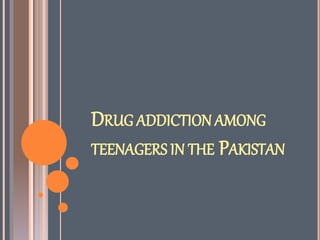Uzair englih ppt
- 1. DRUG ADDICTION AMONG TEENAGERS IN THE PAKISTAN
- 2. REG NO : BSE183064 SECTION : 5. BY: Muhammad Uzair Shafiq
- 5. SIGNSAND SYMPTOMS OF SPECIFIC DRUG USE: METHAMPHETAMINE EFFECTS: ’éó Total loss of appetite ’éó Extreme weight loss ’éó Excited/Talkative COCAINE EFFECTS: ’éó Depressed ’éó Dilated pupils ’éó Hallucinations & Paranoia
- 6. INHALANT EFFECTS: ’éó Silliness & Dizziness ’éó Short-term memory loss ’éó Loss of sense of smell HEROIN EFFECTS: ’éó ŌĆ£NoddingŌĆØ which is a dreamlike state ’éó Completely powerless MARIJUANA EFFECTS: ’éó Compulsive eating ’éó Uncontrollable laughter ’éó Bloodshot red eyes
- 7. RECOGNIZING DRUG ABUSE IN TEENAGERS: 1. Problems at school. (frequently missing classes in school) 2. Physical health issues. (lack of energy and motivation) 3. Neglected appearance. (lack of interest in clothing or grooming) 4. Changes in beavior. (drastic changes in behavior and relationships with family and friends) 5. Spending money. (sudden request for money without a reasonable explanation for its use)
- 8. 12-STEP PROGRAMA common solution for drug addiction is a 12-step program to treat the addiction causing drug use. The program involves forging a meaningful relationship between the recovering addict and sponsor, who helps the addict deal with stress in his/her life and continues to resist drug use. Addicts begin the program by recognizing their powerlessness over the disease and go on to discuss the consequences of their addiction. Over the time, recovering addicts learn to develop meaningful friendships to regulate their emotions, instead of turning to drugs.
- 9. THANK YOU








